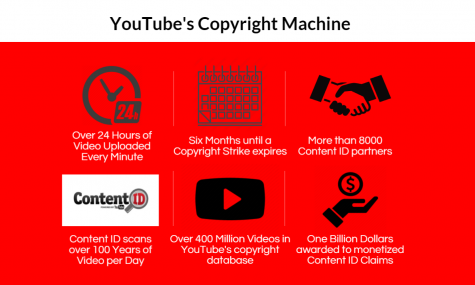YouTube’s corporate copyright censorship system restricts user expression
February 13, 2016
 After the Fine Brothers, creators of the React YouTube channel, submitted trademarks protecting their show’s generic reaction format, public outrage eventually led to the cancellation of all the trademarks and an apology statement from the Fine Brothers. Though the trademark controversy has seemingly ceased, the incident highlighted the issues with YouTube’s aging copyright system.
After the Fine Brothers, creators of the React YouTube channel, submitted trademarks protecting their show’s generic reaction format, public outrage eventually led to the cancellation of all the trademarks and an apology statement from the Fine Brothers. Though the trademark controversy has seemingly ceased, the incident highlighted the issues with YouTube’s aging copyright system.
Two fates await a YouTube video which allegedly contains copyrighted material. The copyright owners can submit a copyright notice. Or the YouTube Content ID, which maintains a database of all copyrighted material submitted to YouTube by copyright owners, automatically alerts the copyright owners of a violation and grants them power over the video. The former leads to a channel’s loss of important features and monetization for a six month period, while the latter leads to a possible removal of the video.
While this system efficiently eliminates full movies and obviously pirated content, it struggles with the gray areas of copyright. As copyright complaints require users to find violations and fill out forms independently, the number of man-hours required in the process makes it unrealistic for small up-and-coming creators to hunt for copyright violations.
n reality, only large multi-channel networks with millions of subscribers and billions of views such as Fullscreen, Machinima and Maker Studios can invest the resources into the copyright process. With 201 to 500 Fullscreen employees, 51 to 200 Machinima employees and 201 to 500 Maker Studios employees, each of these multi-channel networks have more than enough man-hours to make copyright claims.
YouTube’s creator culture, which allows any person with internet access, a camera and a creative idea to potentially be successful, has been replaced with a corporate culture, where new channels exist in constant fear of bullying through copyright. Even more concerning is the power of selective enforcement, where holders can pick which videos to take down.
Media reviews and critique videos are especially vulnerable to suppression and intellectual property strikes due to their frequent usage of copyrighted material. As Content ID detects any matches with copyright content including trailers, posters or clips, avoiding copyright strikes entails review videos with no visual or audio representation of its subject, a recipe for a boring video; all while large channels such as CinemaSins and Screen Junkies post hours of copyrighted clips with no retribution. Though reviews do fall under fair use, YouTube’s Content ID system automatically grants the copyright owner power over the video when it detects the clips used in them. The critic must go through a dispute process and argue that their review falls under fair use to regain control of the video. Unsurprisingly, far more negative reviews are taken down in comparison to positive ones.
YouTube’s Content ID algorithm does not support small channels either. Adding intellectual property to YouTube’s database requires another lengthy submission process, which once again, favors companies over individuals. In both paths of copyright judgment, defendants are presumed guilty until proven innocent. Channels can lose privileges, monetization and their videos if they are accused of copyright violations before they have a chance to challenge accusations, a process that could take weeks.
As YouTube continues to develop with more and more channels and viewers appearing every day, it is paramount for it to implement a just copyright system which leaves room for channels to grow without being at risk of losing their ability to make money and show videos. While YouTube’s copyright system has to be strict in order to maintain a safe environment for copyright holders, channels must be given a chance to defend themselves before they lose necessary features for growth.

Adrian Chu (10) is a reporter for the Winged Post and a columnist for Harker Aquila. He enjoys journalism as it enables him to voice his opinion and to engage in school events as well as international matters. His Opinion column discusses aspects of media influencing society.


















![“[Building nerf blasters] became this outlet of creativity for me that hasn't been matched by anything else. The process [of] making a build complete to your desire is such a painstakingly difficult process, but I've had to learn from [the skills needed from] soldering to proper painting. There's so many different options for everything, if you think about it, it exists. The best part is [that] if it doesn't exist, you can build it yourself," Ishaan Parate said.](https://harkeraquila.com/wp-content/uploads/2022/08/DSC_8149-900x604.jpg)




![“When I came into high school, I was ready to be a follower. But DECA was a game changer for me. It helped me overcome my fear of public speaking, and it's played such a major role in who I've become today. To be able to successfully lead a chapter of 150 students, an officer team and be one of the upperclassmen I once really admired is something I'm [really] proud of,” Anvitha Tummala ('21) said.](https://harkeraquila.com/wp-content/uploads/2021/07/Screen-Shot-2021-07-25-at-9.50.05-AM-900x594.png)







![“I think getting up in the morning and having a sense of purpose [is exciting]. I think without a certain amount of drive, life is kind of obsolete and mundane, and I think having that every single day is what makes each day unique and kind of makes life exciting,” Neymika Jain (12) said.](https://harkeraquila.com/wp-content/uploads/2017/06/Screen-Shot-2017-06-03-at-4.54.16-PM.png)








![“My slogan is ‘slow feet, don’t eat, and I’m hungry.’ You need to run fast to get where you are–you aren't going to get those championships if you aren't fast,” Angel Cervantes (12) said. “I want to do well in school on my tests and in track and win championships for my team. I live by that, [and] I can do that anywhere: in the classroom or on the field.”](https://harkeraquila.com/wp-content/uploads/2018/06/DSC5146-900x601.jpg)
![“[Volleyball has] taught me how to fall correctly, and another thing it taught is that you don’t have to be the best at something to be good at it. If you just hit the ball in a smart way, then it still scores points and you’re good at it. You could be a background player and still make a much bigger impact on the team than you would think,” Anya Gert (’20) said.](https://harkeraquila.com/wp-content/uploads/2020/06/AnnaGert_JinTuan_HoHPhotoEdited-600x900.jpeg)

![“I'm not nearly there yet, but [my confidence has] definitely been getting better since I was pretty shy and timid coming into Harker my freshman year. I know that there's a lot of people that are really confident in what they do, and I really admire them. Everyone's so driven and that has really pushed me to kind of try to find my own place in high school and be more confident,” Alyssa Huang (’20) said.](https://harkeraquila.com/wp-content/uploads/2020/06/AlyssaHuang_EmilyChen_HoHPhoto-900x749.jpeg)









